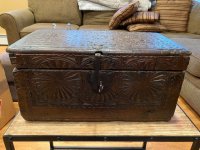Loke
Hero Member
My initial point with it all was really to question the '3000 metres'. It could be 3000 yds, 3000 feet, 3000 chains or whatever. I did not believe the 3000 metres (I might well be wrong!), but if it is not metres - what then. It all could make a helluva difference!!
I can easily agree with Markmar - distances where eye-balled - but ... if put down as meters, this might be a fallacy - and it still makes a helluva difference.
And one more thing - 1:24,000 is just fine with me. But ... how does it it easily translate into 'boots-on-the ground'?
OK - 1" => 24,000" = 2000 ft = 660 yds (or steps - near enough) - but you always need to do the conversion in your head - and what if you do it wrong?
1" on a map is really quite a long distance.
With metrics, 1cm => 240m =265 yds (or steps)
To me, the ultimate test of insanity are those 1"-to-1mile maps - I'm sorry, but that just leaves me stone cold!
Personally, I have been an avid golfer for more years than I care to remember (not that it has helped my score much!!). But ... my distance estimates for anything shorter than a 3-wood (about 220 yds / 200m) has always been almost spot on. I know how far I hit each club in my bag, and when judging (eyeballing) distances, I always think of which club I would use to reach the target. I will never be more than at most 10 yds (or metres!) out. Beats using a 'chain' any day!!
I'm sorry, I promised not to touch the subject again - but ... anything 1:xx000 is just fine with me, what I object to are those fancy 1"/1mile or whatever - hey, what about doing a 1"-to-a-furlong?. Or ... 1"-to-a-quarter-mile?
I can easily agree with Markmar - distances where eye-balled - but ... if put down as meters, this might be a fallacy - and it still makes a helluva difference.
And one more thing - 1:24,000 is just fine with me. But ... how does it it easily translate into 'boots-on-the ground'?
OK - 1" => 24,000" = 2000 ft = 660 yds (or steps - near enough) - but you always need to do the conversion in your head - and what if you do it wrong?
1" on a map is really quite a long distance.
With metrics, 1cm => 240m =265 yds (or steps)
To me, the ultimate test of insanity are those 1"-to-1mile maps - I'm sorry, but that just leaves me stone cold!
Personally, I have been an avid golfer for more years than I care to remember (not that it has helped my score much!!). But ... my distance estimates for anything shorter than a 3-wood (about 220 yds / 200m) has always been almost spot on. I know how far I hit each club in my bag, and when judging (eyeballing) distances, I always think of which club I would use to reach the target. I will never be more than at most 10 yds (or metres!) out. Beats using a 'chain' any day!!
I'm sorry, I promised not to touch the subject again - but ... anything 1:xx000 is just fine with me, what I object to are those fancy 1"/1mile or whatever - hey, what about doing a 1"-to-a-furlong?. Or ... 1"-to-a-quarter-mile?
Amazon Forum Fav 👍
Last edited:











